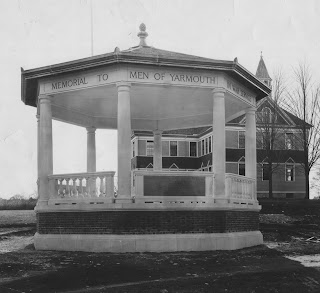I’ve always been intrigued by the slogans that local towns use to proclaim their special historical status. For example, North Yarmouth’s motto, “The town where others began,” is a wistful reminder that five other communities eventually broke away from North Yarmouth’s original territory. “Our latchstring is always out,” is Yarmouth’s cheerfully quaint motto, one that surely makes for a dubious zoning policy. But it is Freeport’s claim to be “the birthplace of Maine” that is the most perplexing. Like the ghost ship of Harpswell, that slogan sails on through popular belief propelled only by local pride and wishful thinking.

This building was called the Jameson Tavern when a group of men met there in July 1819 to OPPOSE the idea of Maine becoming a state.
Freeport’s claim to Maine’s birthright rests on two historical facts, each of which contains a kernel of truth, but neither of which offers any support for the local statehood legend. (For those of you who would like to examine these facts more closely, I highly recommend Ronald Banks’ book, Maine Becomes a State as well as the discussion of this issue in Three Centuries of Freeport by Thurston and Cross.)
The Freeport version of the story takes place shortly after Maine became a state on March 15th 1820. To disentangle lingering problems, commissioners from Massachusetts and Maine met eight times between 1820 and 1827. According to local partisans, the final meeting of those commissioners was held at the Jameson Tavern where a stroke of the pen severed the last ties between the two states. Leaving aside the fact that Maine had already been a state for seven years when the commissioners held their final meeting, there is a the serious problem that the joint commission never met in Freeport–not at the Jameson Tavern or anywhere else. Their only meetings were in Boston, Portland, Bangor and Augusta.
The second piece of evidence that is offered for Freeport’s role in Maine statehood rests with a meeting that actually did take place at the Jameson Tavern, just days before the final referendum in July 1819. The men who gathered there were some of the most influential politicians, merchants and civic leaders from coastal Maine including Senator Samuel Fessenden, the land baron Robert Gardiner and Yarmouth’s Edmund Russell who commanded the local militia forces during the War of 1812. These men were conservative Federalists with close economic and cultural ties to Massachusetts, men whose control over the District of Maine had steadily eroded as settlers pushed inland from the coast. These eastern pioneers were more likely to be evangelicals and Jeffersonians in sharp contrast to the Congregational elite. Above all, the district’s feisty new settlers overwhelmingly endorsed the idea of breaking away from what they perceived as bondage to Massachusetts.
The dozens of men who gathered at the Jameson Tavern in July 1819 also held very strong opinions about Maine statehood. Unfortunately for the local legend, they were strongly OPPOSED to Maine’s becoming a state. Many of them came to defend Bowdoin College whose funding and governance would be threatened by the transfer of power to a new Maine legislature. These influential leaders included Stephen Longfellow Jr. who was a Portland lawyer and the father of the famous poet. Joseph McKeen, the son of Bowdoin’s first president, wanted guarantees that the new legislature would continue to subsidize the college to the tune of $3000 per year. Another advocate of the college was the school’s lawyer, Benjamin Orr who had the audacity to put a lien on the assets of William King, the undisputed leader of the statehood movement (and soon to become Maine’s first governor). As a trustee of Bowdoin, Dr. Ammi Mitchell from North Yarmouth showed up to defend not only the college but also the maritime interests of his town.
I believe that Freeport was selected to host the district’s only formal meeting to oppose the 1819 referendum because it was more than a convenient stop between Portland and Brunswick. It was also very friendly territory for these opponents of the separation movement. Sentiment in the town ran deeply in favor of Bowdoin College and very strongly against the movement toward statehood. The town’s support for Bowdoin reached back to the school’s inception in the 1790’s when Reverend Alfred Johnson of the 1st Parish church raised a large amount of money to have the college located in Freeport. It’s not surprising that a number of prominent Freeport men also attended the 1819 meeting including Barstow Sylvester, Josiah W. Mitchell (a lawyer who served as Freeport’s town treasurer) and Dr. John A. Hyde who was the town’s most respected physician.
Freeport’s opposition to statehood was also fueled by fears that independence from Massachusetts would be a costly victory for the town’s shipbuilders, sea captains and merchants. Until a last minute change was made to the Coastal Shipping Law, Maine vessels doing business along the Atlantic coast would have been forced to stop and pay customs in nearly every eastern state that they sailed past. Although this provision was modified before the 1819 vote, it helps to explain why the citizens of Freeport voted AGAINST statehood in every one of the six statehood referendums held between 1792 and 1819.











